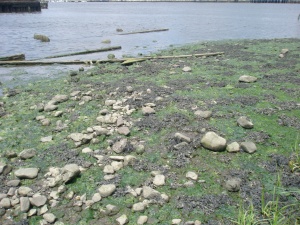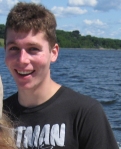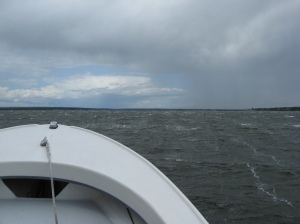On June 22nd the crew took a helicopter survey and found many areas of Narragansett Bay to be heavily loaded with algae. Some areas, particularly the coves in Greenwich Bay, had a milky hue to them which is indicative of low dissolved oxygen. Much of Greenwich Bay and Allen Harbor had bright red streaks in the water.
 |
| The red streaks in the water are patches of the dinoflagellate Gynodinium. |
Certain types of phytoplankton (microscopic algae) grow very quickly and form thick, visible patches. Some of these phytoplankton blooms are harmful to plants, animals and humans, and are known as harmful algal blooms (HAB). After we landed we traveled down to Allen Harbor to collect a water sample to take back to the lab and look at under the microscope. Fortunately, the red phytoplankton we saw was not a HAB. A fellow professor here at the URI Bay campus identified it to be
a harmless species of
Gymnodinium, a dinoflagellate. There are however, several species of
Gymnodinuim that produce toxins that cause shellfish poisoning. These red-tide events often coincide with high concentrations of nutrients, especially iron and high temperatures.
After our aerial flights we go out to the beaches to identify the algae species seen from the air. As expected, we found the northern part of the Bay (north of Conimicut) loaded with the green algae
Ulva species (sea lettuce). Conimicut and many areas south to Narragansett beach have a wide variety of red, green and brown algae.
 |
| The green seaweed Ulva and brown seaweed Fucus cover Bold Point. |
 |
- A mix of reds, greens and browns were found at Sabin point.
|










